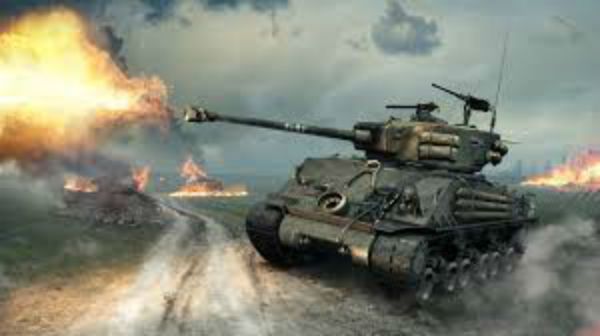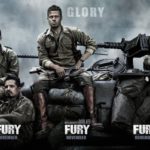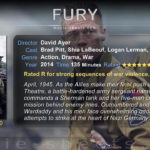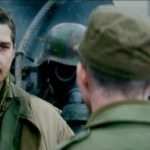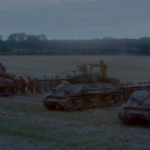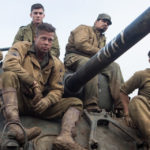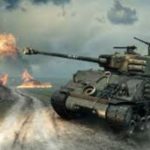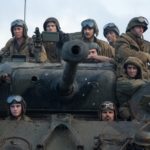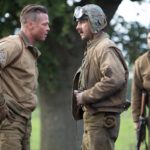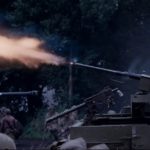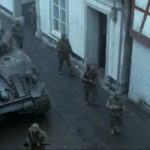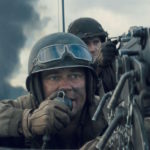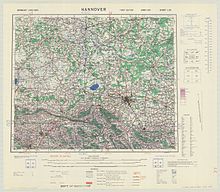“Ideas are peaceful, history is violent” – SSG Don Collier, Fury
Imagine for a moment you know nothing whatever about World War II, and I mean zilch. Oh, and you had no choice but to rely on Hollywood movies to learn you history. What kind of distorted image would you pick up?
Probably that this was a straight fight between the evil Nazis and the all-conquering American heroes. British? French? Usually nowhere to be seen. The film will probably start with a team of heroes with a full spectrum of personalities with their backs to the wall overcome moral dilemmas and team conflicts to defy the odds and win the day, wiping out countless gooks, sorry krauts in the process.
If you expected Fury (one of no fewer than 8 films with the same title, from 1923 to 2016) to be any different, stop reading now. This is not a bad film, nor anything like it, but I think it is high time to change the broken record and stop rewriting history. Anyway, the box of Fury declares:
“The best war film since Saving Private Ryan” – Pete Hammond, Deadline Hollywood
This is almost certainly because Fury follows pretty much the same template – Saving Private Ryan in tanks, maybe? I have no doubt that it was meticulously researched, that the tanks and the scenario in writer-director David Ayer‘s film are authentic (see quotes from Wikipedia at the bottom of this review), that the characters are honed based on original accounts, but I can’t help feeling this is a formulaic, straight-jacketed war film following in the path of many that preceded it.
In context what Ayer serves up is first and foremost an action movie where the heroes are essentially there to kill Germans, and for the most part do so without compunction (women excepted), and secondly a buddy movie where a tank crew of divergent personalities is thrown together under the command of phlegmatic battle-hardened Staff Sergeant Don “Wardaddy” Collier (Brad Pitt), who in one his more brooding, philosophical moments quotes forth the words at the top of this review.
Exactly like SPR, the veteran platoon leader dies to save the fresh-faced newbie (in this case Logan Lerman‘s Private Norman “Machine” Ellison.) Along the way, the crews of four tanks are whittled down to one as they spend their precious ammo gunning for German tanks and forces, before Collier decides chances are against their survival as the tank loses a track in a mine explosion so opts to hold the crossroads and wipe out a division of German soldiers in “unsere Land” (useful reminder of how Afghans and Iraqis might have felt about American and British forces landing in their country.) This being 1945, they are relieved, too late, by – guess what – American forces, they having won the war.
I said there were no Brits in evidence, but that is not strictly true. Our very own Jason Isaacs makes a passing appearance as Captain “Old Man” Waggoner. That apart, the crews comprise pugnacious vets like Boyd “Bible” Swan (Shia LaBoeuf), Cpl Trini “Gordo” Garcia (Michael Peña to provide Hispanic token balance), PFC Grady “Coon-Ass” Travis (John Bernthal) and several more mud-covered tough guys with dumb nicknames. All are acted competently, but rarely given the opportunity to demonstrate their credentials.
Far and away the most effective scene of the film bucks that trend. The crew ends in a town and, having killed off several Nazi snipers who reduce their manpower by two men, encounter two German women, Irma (Romanian Anamaria Marina) sheltering Alicia von Rittberg‘s nervous but playful Emma from a fate worse than death in one of the few intact houses. Collier has them cook breakfast for his motley and abusive crew, while we are led to believe that in that short space of time Ellison falls in love with and kisses Emma, who is of course killed a few minutes later in an air strike, much to Ellison’s chagrin – not that it takes long for him to forget her and develop a taste for machine-gunning Germans himself.
Far-fetched story elements notwithstanding, the scene works on several levels and is a dramatic success, more so than the cartoonish violence of the later scenes, which on occasions mimics the deadpan death squad led by the self-same Brad Pitt’s First Lieutenant Aldo “The Apache” Raine in Tarantino‘s Inglourious Basterds, a fact I’m sure was not lost on Pitt. Not that you’d know it from his performance, which is for the most part strong, silent and noble – apart from when he forces Ellison to shoot a German solider in the back and barks orders to recalcitrant crew members.
But let’s face facts here: time for Hollywood to move on and to stop glorifying the American role in WWII, and indeed, in any other conflict. At least films like 12 Years A Slave and Selma confront viewers with uncomfortable truths about a history of cruelty and intolerance, but this is a form of exploitation, telling a version of history that adds little to our previous understanding.
___
Fury is a fictional film about a tank crew during the final days of the war in Europe. Ayer was influenced by the service of veterans in his family and by reading books such as Belton Y. Cooper’s Death Trapsabout American armored warfare in World War II. Ayer went to considerable lengths to seek authentic uniforms and weapons appropriate to the period of the final months of the war in Europe. The film was shot in England in large part due to the availability of working World War II-era tanks. The film featured a Tiger 131, the last surviving operational Tiger I. The tank belongs to The Tank Museum at Bovington, England. It is the first time since the 1950 film They Were Not Divided that a real Tiger tank, not a prop version, has been used on a film set. Tiger 131 is a very early model Tiger I tank; externally it has some significant differences from later Tiger I models, most noticeably the outermost row of road wheels (of the trio per axle, used in the Schachtellaufwerk overlapping and interleaved arrangement characteristic of the Tiger I) which are also rimmed in rubber, as well as the dustbin shaped cupola. In the last weeks of the war a number of these early model Tigers were used in last ditch defense efforts; one of Germany’s last Tigers to be lost at the Brandenburg Gate in Berlin was of a similar vintage.
Ten working M4 Sherman tanks were used. The Sherman tank Fury was played by an M4A2 Sherman tank named RON/HARRY (T224875), also lent by The Tank Museum. Ayer’s attention to detail also extended to the maps used in the film. A 1943 wartime map of Hannover, Germany held in McMaster University’s Lloyd Reeds Map Collection was used to demonstrate the types of resources relied on by Allied forces.
While the plot of the film is fictional, the depiction of the tank Fury and its commander Wardaddy parallels the experience of several real Allied tankers, such as the American tank commander Staff SergeantLafayette G. “War Daddy” Pool who landed just after D-Day and destroyed 258 enemy vehicles before his tank was knocked out in Germany in late 1944, and the small number of Sherman tanks to survive from the landing at D-Day to the end of the war, such as Bomb, a Sherman tank that landed at D-Day and survived into the bitter fighting in Germany at the war’s end, the only Canadian Sherman tank to survive the fighting from D-Day to VE Day. The plot also has some similarities to the battle of Crailsheim, fought in Germany in 1945. The last stand of the crew of the disabled Fury appears to be based on an anecdote from Death Traps, where a lone tanker was “in his tank on a road junction” when a “German infantry unit approached, apparently not spotting the tank in the darkness.” This unnamed tanker is described to have ricocheted shells into the enemy forces, fired all of his machine gun ammunition and thrown grenades to kill German soldiers climbing onto the tank. Cooper concluded: “When our infantry arrived the next day, they found the brave young tanker still alive in his tank. The entire surrounding area was littered with German dead and wounded.” The battle bears some resemblance to that of Medal of Honor recipient Audie Murphy aboard a burning M10 tank destroyer outside Holtzwihr in Alsace-Lorraine on January 26, 1945. The fighting in the film also bears similarity to the 1943 film Sahara starring Humphrey Bogart in which the crew of an M3 Lee named “Lulu Belle” and a contingent of stranded British soldiers, defend a remote well in Libya against a larger German force of the Afrika Korps, to the demise of most of the Allies.

